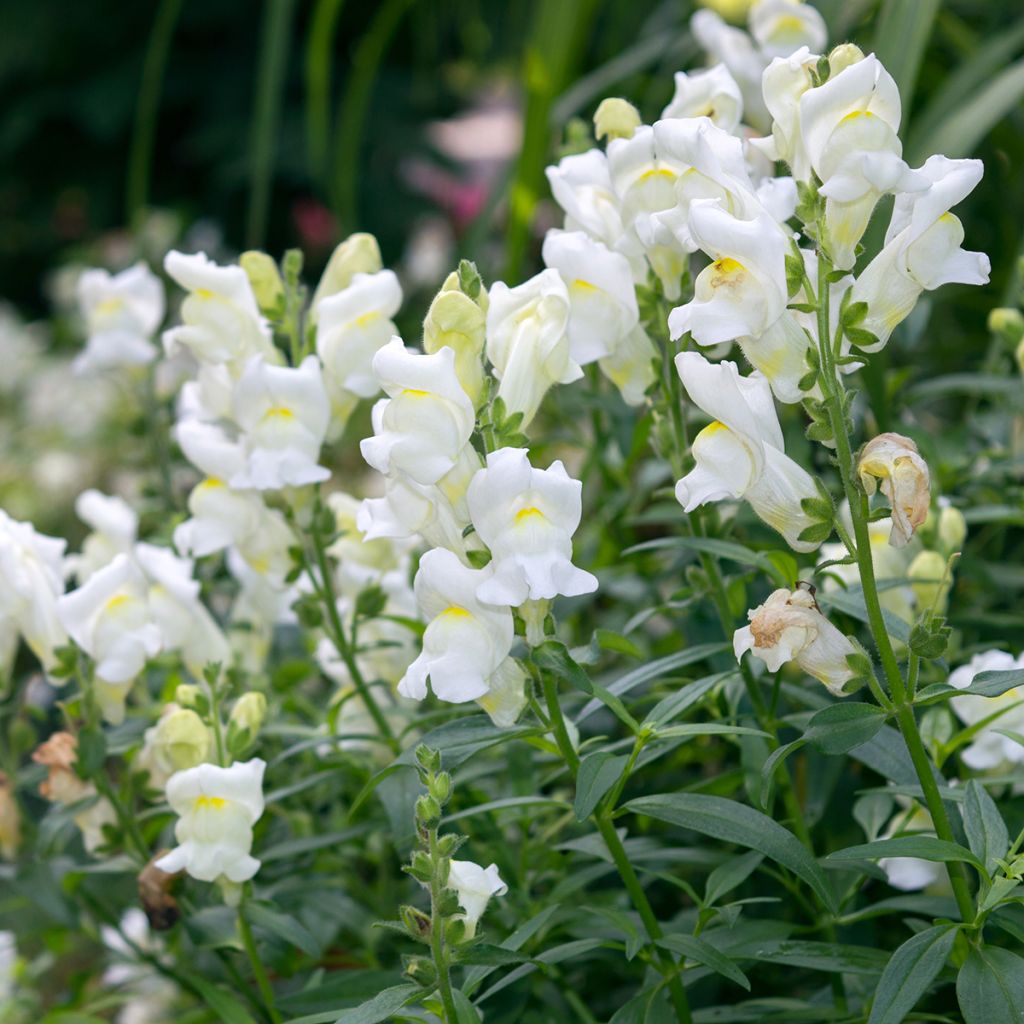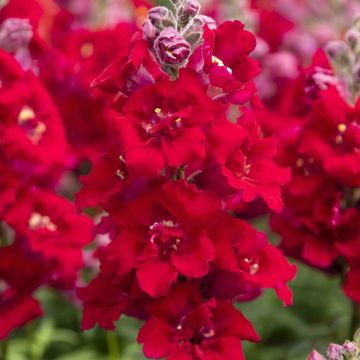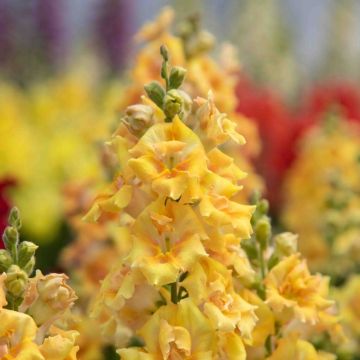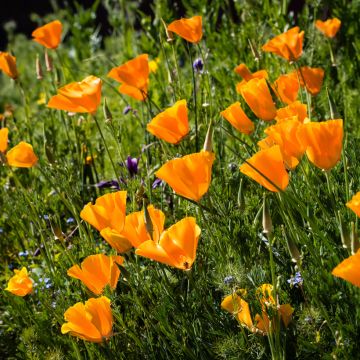

Snapdragon Royal Bride Seeds - Antirrhinum majus


Snapdragon Royal Bride Seeds - Antirrhinum majus


Snapdragon Royal Bride Seeds - Antirrhinum majus
Snapdragon Royal Bride Seeds - Antirrhinum majus
Antirrhinum x majus Royal Bride
Snapdragon
No success with these seeds. Nothing at all!! What a shame! Why don't you sell them in buckets? It would be easier for me. Thank you.
Odile, 24/08/2018
Special offer!
Receive a €20 voucher for any order over €90 (excluding delivery costs, credit notes, and plastic-free options)!
1- Add your favorite plants to your cart.
2- Once you have reached €90, confirm your order (you can even choose the delivery date!).
3- As soon as your order is shipped, you will receive an email containing your voucher code, valid for 3 months (90 days).
Your voucher is unique and can only be used once, for any order with a minimum value of €20, excluding delivery costs.
Can be combined with other current offers, non-divisible and non-refundable.
Why not try an alternative variety in stock?
View all →This plant carries a 6 months recovery warranty
More information
We guarantee the quality of our plants for a full growing cycle, and will replace at our expense any plant that fails to recover under normal climatic and planting conditions.

Would this plant suit my garden?
Set up your Plantfit profile →
Description
Antirrhinum majus 'Royal Bride' is a wonderfully scented variety that features majestic flower spikes of the purest white, set against deep green leaves. The long, sturdy stems are perfect for cutting! Snapdragons are annuals or short-lived perennials depending on the climate and soil. These easy-going, prolific bloomers self-seed in the most unlikely of places. Grow in well-prepared, free-draining soil in full sun.
Antirrhinum majus, commonly referred to as Snapdragon, has been grown in gardens since the 16th century. It belongs to the Scrofulariaceae family and is native to the west of the Mediterranean basin where it grows between rocks and on dry slopes. It is often found growing in between cracks in old garden walls. 'Royal Bride' is large variety that forms 65 cm tall and 35 cm wide clumps. The erect stems are covered with opposite or alternate linear to lanceolate leaves, deep green in colour. From May-June to September-October (or the first frosts), dense, sturdy flower spikes emerge. The large, tubular flowers are pure white and intensely fragrant. Snapdragons are a magnet to bees and butterflies. They self-seed easily in light soil, however they are not always true to type.
Snapdragons are easy to grow, perfect for naturalistic gardens, scented gardens, and cottage gardens. They are generally treated as annuals in heavy soil and colder climates. Large varieties such as 'Royal Brides' are perfect for growing in borders, flower beds and rock gardens. They are also ideal for cutting! This variety combines well with Love-in-a-mist, Cosmos or annual poppies. Snapdragons’ colourful flower spikes look particularly attractive amongst bushy perennials (fennel, ox-eye daisies, cardoons, asters, perennial chrysanthemums) or small, neutral-coloured shrubs (lavender, santolina, mugwort, euphorbia, Thymus hirsutus) ... Once the plants are well established, we recommend removing spent flowers regularly to extend the blooming period.
Snapdragon seeds are best left to experienced, seasoned gardeners as they are extremely small, like fine dust.
Report an error about the product description
Snapdragon Royal Bride Seeds - Antirrhinum majus in pictures


Flowering
Foliage
Plant habit
Botanical data
Antirrhinum
x majus
Royal Bride
Scrophulariaceae
Snapdragon
Cultivar or hybrid
Other Antirhinum - Snapdragon seeds
View all →Planting and care
Sow from January to March on the surface of light, well-drained sowing mix (without covering the seeds). Place in a propagator or polythene bag and keep in a light room at a temperature of 20-25°C until germination (generally 10 to 21 days). Make sure the soil stays moist but not waterlogged. When the seedlings are strong enough to handle, transplant them into pots. Harden them off gradually for a few weeks. When all risk of frost is over, plant them out in a sunny location, leaving 25-30 cm between each plant.
Snapdragons thrive in fertile, well-drained, loose soil, in full sun. They are not very cold hardy (down to -7°C) and are often grown as annuals or biennials. However, it is not uncommon to see snapdragon plants surviving for several years if winters are not too harsh. However, this makes them more vulnerable to rust. To keep your plants from year to year, make sure to provide them with excellent drainage and bury them under a thick layer of dry leaves or grass clippings to protect them from harsh frosts. They will reappear the following spring and flower earlier.
Sowing period
Intended location
-
, onOrder confirmed
Reply from on Promesse de fleurs
Similar products
Haven't found what you were looking for?
Hardiness is the lowest winter temperature a plant can endure without suffering serious damage or even dying. However, hardiness is affected by location (a sheltered area, such as a patio), protection (winter cover) and soil type (hardiness is improved by well-drained soil).

Photo Sharing Terms & Conditions
In order to encourage gardeners to interact and share their experiences, Promesse de fleurs offers various media enabling content to be uploaded onto its Site - in particular via the ‘Photo sharing’ module.
The User agrees to refrain from:
- Posting any content that is illegal, prejudicial, insulting, racist, inciteful to hatred, revisionist, contrary to public decency, that infringes on privacy or on the privacy rights of third parties, in particular the publicity rights of persons and goods, intellectual property rights, or the right to privacy.
- Submitting content on behalf of a third party;
- Impersonate the identity of a third party and/or publish any personal information about a third party;
In general, the User undertakes to refrain from any unethical behaviour.
All Content (in particular text, comments, files, images, photos, videos, creative works, etc.), which may be subject to property or intellectual property rights, image or other private rights, shall remain the property of the User, subject to the limited rights granted by the terms of the licence granted by Promesse de fleurs as stated below. Users are at liberty to publish or not to publish such Content on the Site, notably via the ‘Photo Sharing’ facility, and accept that this Content shall be made public and freely accessible, notably on the Internet.
Users further acknowledge, undertake to have ,and guarantee that they hold all necessary rights and permissions to publish such material on the Site, in particular with regard to the legislation in force pertaining to any privacy, property, intellectual property, image, or contractual rights, or rights of any other nature. By publishing such Content on the Site, Users acknowledge accepting full liability as publishers of the Content within the meaning of the law, and grant Promesse de fleurs, free of charge, an inclusive, worldwide licence for the said Content for the entire duration of its publication, including all reproduction, representation, up/downloading, displaying, performing, transmission, and storage rights.
Users also grant permission for their name to be linked to the Content and accept that this link may not always be made available.
By engaging in posting material, Users consent to their Content becoming automatically accessible on the Internet, in particular on other sites and/or blogs and/or web pages of the Promesse de fleurs site, including in particular social pages and the Promesse de fleurs catalogue.
Users may secure the removal of entrusted content free of charge by issuing a simple request via our contact form.
The flowering period indicated on our website applies to countries and regions located in USDA zone 8 (France, the United Kingdom, Ireland, the Netherlands, etc.)
It will vary according to where you live:
- In zones 9 to 10 (Italy, Spain, Greece, etc.), flowering will occur about 2 to 4 weeks earlier.
- In zones 6 to 7 (Germany, Poland, Slovenia, and lower mountainous regions), flowering will be delayed by 2 to 3 weeks.
- In zone 5 (Central Europe, Scandinavia), blooming will be delayed by 3 to 5 weeks.
In temperate climates, pruning of spring-flowering shrubs (forsythia, spireas, etc.) should be done just after flowering.
Pruning of summer-flowering shrubs (Indian Lilac, Perovskia, etc.) can be done in winter or spring.
In cold regions as well as with frost-sensitive plants, avoid pruning too early when severe frosts may still occur.
The planting period indicated on our website applies to countries and regions located in USDA zone 8 (France, United Kingdom, Ireland, Netherlands).
It will vary according to where you live:
- In Mediterranean zones (Marseille, Madrid, Milan, etc.), autumn and winter are the best planting periods.
- In continental zones (Strasbourg, Munich, Vienna, etc.), delay planting by 2 to 3 weeks in spring and bring it forward by 2 to 4 weeks in autumn.
- In mountainous regions (the Alps, Pyrenees, Carpathians, etc.), it is best to plant in late spring (May-June) or late summer (August-September).
The harvesting period indicated on our website applies to countries and regions in USDA zone 8 (France, England, Ireland, the Netherlands).
In colder areas (Scandinavia, Poland, Austria...) fruit and vegetable harvests are likely to be delayed by 3-4 weeks.
In warmer areas (Italy, Spain, Greece, etc.), harvesting will probably take place earlier, depending on weather conditions.
The sowing periods indicated on our website apply to countries and regions within USDA Zone 8 (France, UK, Ireland, Netherlands).
In colder areas (Scandinavia, Poland, Austria...), delay any outdoor sowing by 3-4 weeks, or sow under glass.
In warmer climes (Italy, Spain, Greece, etc.), bring outdoor sowing forward by a few weeks.






















































